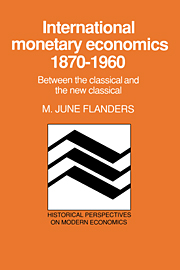Book contents
- Frontmatter
- Contents
- Preface
- 1 Preliminaries
- 2 Stream P
- 3 The beginnings of the neoclassical tradition
- 4 The locus classicus of the neoclassical position
- 5 The Macmillan Committee
- 6 A second diversion: Keynes and the Macmillan Committee
- 7 The anti-neoclassicals
- 8 Indian currency and finance: a tract on monetary reform
- 9 A treatise on money
- 10 Late Keynes: towards Bretton Woods
- 11 The crisis writers
- 3 Stream F
- 4 The confluence
- Ex post
- Bibliography
- Index
8 - Indian currency and finance: a tract on monetary reform
Published online by Cambridge University Press: 12 October 2009
- Frontmatter
- Contents
- Preface
- 1 Preliminaries
- 2 Stream P
- 3 The beginnings of the neoclassical tradition
- 4 The locus classicus of the neoclassical position
- 5 The Macmillan Committee
- 6 A second diversion: Keynes and the Macmillan Committee
- 7 The anti-neoclassicals
- 8 Indian currency and finance: a tract on monetary reform
- 9 A treatise on money
- 10 Late Keynes: towards Bretton Woods
- 11 The crisis writers
- 3 Stream F
- 4 The confluence
- Ex post
- Bibliography
- Index
Summary
I shall concentrate primarily on Keynes's formal writings and leave aside his letters, newspaper articles, and memoranda, with two important exceptions. I felt that I must devote attention to the letters and memoranda issuing from his preparations for the Bretton Woods meetings (which, by the way, take up a whole volume of his Collected writings). And I have incorporated, in the discussion of the Macmillan Committee Report (Chapter 6), Keynes's own testimony to that committee, of which he was a member.
Somebody has commented (may I be forgiven the churlishness of not referring to the person by name? I do not remember where I read it) that Keynes's writings moved monotonically from openness to closedness over his lifetime. His first book, Indian currency and finance (1913), described the functioning of an economy on the gold reserve standard, specifically a sterling standard, with India holding its reserves in sterling and Britain holding its in gold. It was written at a time when the continued existence of the international gold standard (or at least the gold exchange standard) was not seriously open to doubt.
The next work, the Tract on monetary reform, was about the world monetary system. It appeared in 1923, when Britons in particular were asking what kind of regime, and what exchange rates, would be appropriate to the postwar world.
- Type
- Chapter
- Information
- International Monetary Economics, 1870–1960Between the Classical and the New Classical, pp. 155 - 169Publisher: Cambridge University PressPrint publication year: 1990
- 1
- Cited by



